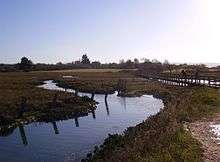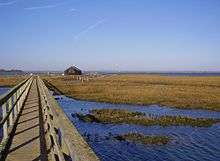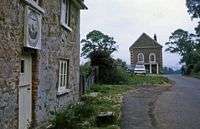Newtown, Isle of Wight
Coordinates: 50°42′33″N 1°23′33″W / 50.70912°N 1.39243°W
Newtown is a small hamlet on the Isle of Wight, England. In medieval times it was a thriving borough.
Newtown is located on the large natural harbour on the island's north-western coast, now mostly a national nature reserve owned and managed by the National Trust.
The Caul Bourne stream through Calbourne passes Newbridge and Shalfleet and empties into the Solent at Newtown.
History



The town was originally called Francheville (i.e. 'Freetown'), and only later renamed Newtown. It was probably founded before the Norman Conquest. There is some indication that it was attacked by Danes in 1001.
The earliest known charter was granted by the Bishop-elect of Winchester, Aymer de Valence. He signed it at his ecclestical estate of Swainston Manor in 1256. The early hopes for its success are reflected in the names of its streets, such as Gold Street and Silver Street. However, it will have had competition from Yarmouth, Newport and Southampton. In 1284 it was somewhat reluctantly given to Edward I. Apparently there were about 60 families living in Newtown at the start of the 14th century.
By the mid 14th century, Newtown was starting to mature into a thriving commercial centre. In 1344, it was assessed at twice the value of Newport. Its harbour was busy and reputed to be the safest on the island. There was a prosperous saltworks and abundant oyster beds. There was an annual three-day festival on the "eve, the day and the morrow of the Feast of St. Mary Magdalen", who was honoured in the name of the local thirteenth-century chapel. Then, the plague struck, and subsequently a French raid in 1377 destroyed much of the town, from which it never recovered.
By the middle of the 16th century, it was a small settlement eclipsed by the more easily defended town of Newport. A survey in 1559 noted that Newtown no longer had a market, and did not have a single good house still standing. Its harbour slowly became clogged with silt and inaccessible to larger vessels.
In 1584 Elizabeth I breathed some life into the town by awarding it two parliamentary seats. A town hall was built in the 17th century. However, these seats ultimately made Newtown borough one of the most notorious of the rotten boroughs, prevalent in the UK before the 19th century reforms. By the time of the 1832 Reform Act that abolished the seats, a survey found that Newtown had just fourteen houses and twenty-three voters, whilst massively larger municipal areas with many more voters had less representation.
The town hall was restored in 1813, and again in the 1930s. It is now open to the public.
The Newtown Arms Inn was closed in 1916. It was in an unusually shaped building referred to locally as "Noah's Ark."
Newtown remained small, but this has preserved its original layout, which is of historical interest. There are two square ponds by the boathouse, which were dug as salterns as part of the former local salt industry.
Legend
There are stories of a pied piper, hired for 50 pounds to save Newtown from an excess of rats, which are similar to the story of the Pied Piper of Hamelin, Germany. He is said to have played his pipe and led the rats into the Solent, where they drowned. The townspeople refused to pay the agreed price, and gave the piper 20 pounds, so he then led the children away. The town lost an entire generation, so had no young people to defend it when the French attacked in 1377.
Transport
Southern Vectis operates an infrequent bus route 35, Newbridge to Newport, via Newtown, Porchfield and Marks Corner.[1]
References
- ↑ "Route 35" (PDF). Southern Vectis. 2013. Retrieved 2013-06-12.
External links
| Wikimedia Commons has media related to Newtown, Isle of Wight. |

